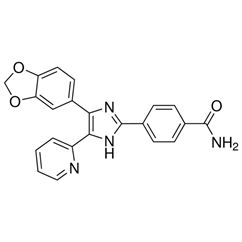Recombinant Human ACRP-30

Cytotoxicity assay for Human ACRP-30. Cell viability was measured to calculate the ED50, which is in the expected range of 1.0 - 2.5 μg/ml.

Non-reducing (-) and reducing (+) conditions in a 4 - 20% Tris-Glycine gel stained with Coomassie Blue. 1 μg of protein was loaded in each lane. Human ACRP-30 has a predicted Mw of 16.7 kDa.
Achieve Purchasing Synergy
Request a quote at [email protected] for 2 or more vials of any Growth Factor to receive a discount. Discounts range from 5 to 20% according to the size of your order.
PODS® Growth Factors
The product is currently not available as PODS®, please check back in the future.Description
The globular subunit of adipocyte complement-related protein of 30 kDa (globular ACRP-30) is a naturally occurring cleavage product of adiponectin. Produced exclusively by adipocytes, globular ACRP-30 is an abundant serum protein and plays an important role in hyperglycemia, insulin resistance, and fatty acid oxidation. Globular ACRP-30 signals through adiponectin receptor 1 (AdipoR1) and adiponectin receptor 2 (AdipoR2).Activity Assay
Human ACRP-30 is fully biologically active when compared to standard. The activity is determined by the ability to inhibit the proliferation of mouse M1 cells and it is typically 2 ng/ml. This corresponds to an expected specific activity superior to 500 units/mg.AA Sequence
MKGEPGEGAY VYRSAFSVGL ETYVTIPNMP IRFTKIFYNQ QNHYDGSTGK FHCNIPGLYY FAYHITVYMK DVKVSLFKKD KAMLFTYDQY QENNVDQASG SVLLHLEVGD QVWLQVYGEG ERNGLYADND NDSTFTGFLL YHDTNAlternative Names
Adiponectin, adipolean, ACRP30, globular domain of Acrp30, apm-1, APM-1, apM-1, APM1, apM1, C1Q and collagen domain containing, ACDC, ADPN, GBP28, ADIPQTL, AdipoQ, gelatin-binding protein 282, adipocyte, 30 kDa adipocyte complement-related protein, adipocyte complement-related 30 kDa protein, adipose most abundant gene transcript 1 protein, gelatin-binding protein| Product Details | |
|---|---|
| Length | 145 aa |
| Molecular Weight | 16.7 kDa |
| Structure | Monomer |
| Source | E. coli |
| Accession Number | Q15848 |
| Purity | ≥95% determined by reducing and non-reducing SDS-PAGE |
| Endotoxin Level | ≤1.00 EU/μg as measured by kinetic LAL |
| Formulation | Lyophilized from a sterile (0.2 micron) filtered aqueous solution containing 10 mM Sodium Phosphate, 0.75 mM DTT, pH 8.0 |
| Reconstitution | Centrifuge vial before opening. When reconstituting the product, gently pipet and wash down the sides of the vial to ensure full recovery of the protein into solution. It is recommended to reconstitute the lyophilized product with sterile 10 mM Sodium Phosphate and 0.5 mM DTT, pH 7.5, which can be further diluted into other aqueous solutions. |
| Stability and Storage |
12 months from date of receipt when stored at -20°C to -80°C as supplied. 1 month when stored at 4°C after reconstituting as directed. 3 months when stored at -20°C to -80°C after reconstituting as directed. |






